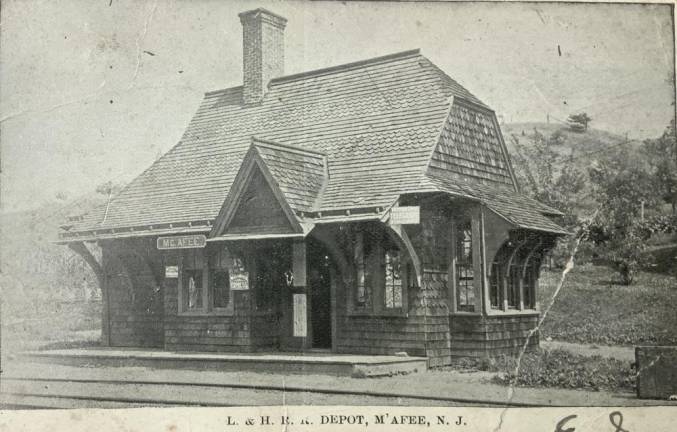
This week I am delighted to have a noted guest writer. This is the published and esteemed historian from the Vernon area Ron Dupont.
Ron is a lifelong resident of the township and Columbia University grad. He has researched and journeyed his end of our county extensively.
From the lofty Wawayanda forests with grand views down to the lowlands and gentle cattle pastures of the valley, he has recorded Vernon’s history.
He has documented the iron sources and a mighty furnace and has waded the Pequannock River in search of the tri-county marker as he traveled in the footsteps of ancient Hiram Strait.
He has witnessed the transition of Vernon from the quaint rural era to the modern times of skiing and golf and resorts.
Thank you, Ron.
***
Looking at this historic photo, many local residents would assume that it’s an old picture of Place by the Tracks, the popular deli housed in Vernon’s historic 1880 Lehigh & Hudson River Railroad depot.
But they’d be wrong.
In fact, it is that building’s McAfee “twin,” which stood just off Route 94.
While the Vernon depot has long had a second life as a deli and other businesses, the McAfee depot is long gone - it still stands, but it’s not even in New Jersey anymore.
Both depots were built by what was originally called the Wawayanda Rail Road Co., later merged into the Lehigh and Hudson River Railway.
This was constructed to connect the Warwick Valley Railroad in Warwick, N.Y., to the Sussex Railroad at McAfee.
Ground for the railroad was broken in Vernon on Saturday, Aug. 9, 1879, with numerous local notables in attendance, including Capt. Daniel Bailey. The Warwick Advertiser trumpeted, “In a few months’ time, the beautiful Vernon Valley and its surrounding mountains, which have gently slept since the dawn of creation, will be awakened from their slumbers and will reverberate to the shrill scream of the locomotive and the thunder of the passing trains.”
A crew of more than 500 men pushed construction fast, working straight through the winter, and by late May 1880, the line was finished.
Eleven miles of railroad built in slightly more than nine months! You would not see that today. And they did it mostly with manual labor.
As for the Vernon and McAfee depots, they were under construction by April 1880. Warwick contractor Thomas Galloway had the contract to build them, and the Warwick Advertiser noted, “The passenger depots will be neat and tasty and will afford more than the usual accommodations,” adding, “The roof and sides will be covered in California redwood shingles.”
The Vernon and McAfee depots were not, in fact, identical but slightly different from each other. A trip from McAfee to Warwick, with stops at Vernon and New Milford, took 30 minutes.
The history of the McAfee depot is covered in Paul Miller’s excellent 2008 history of this railroad, “Tracking Down the Lehigh and Hudson.”
The depot stood amid a small complex of railroad-related buildings just south of the railroad crossing on Route 94 in McAfee, all of which have vanished.
The depot stood about 300 feet south of Route 94 on the east side of the tracks, along with a freight house, an engine house, multiple sidings and spur, and a large house. A creamery stood on the other side of the tracks. All were served by one road leading in parallel to the tracks, and another across Black Creek from Route 94.
All that survives is the driveway between the George Inn and the McAfee Fire Department. Everything else is now gone.
The glory days of the railroad in McAfee were not long: The limestone quarries had closed by the late 1920s, and with the automobile dominating, all passenger service on this stretch of line ceased in April 1934 (as told me by Warwick historian Marty Feldner).
The McAfee depot was sold in September 1936 to Warwick fruit farmer Edwin S. Fancher for $50. He moved it up to his farm in Warwick for use as a tenant house.
Still there, sitting right next to Route 94, it is now a cottage on the River Run Estate at 230 Route 94 in New Milford.
Contact Bill Truran, Sussex County historian, at billt1425@gmail.com